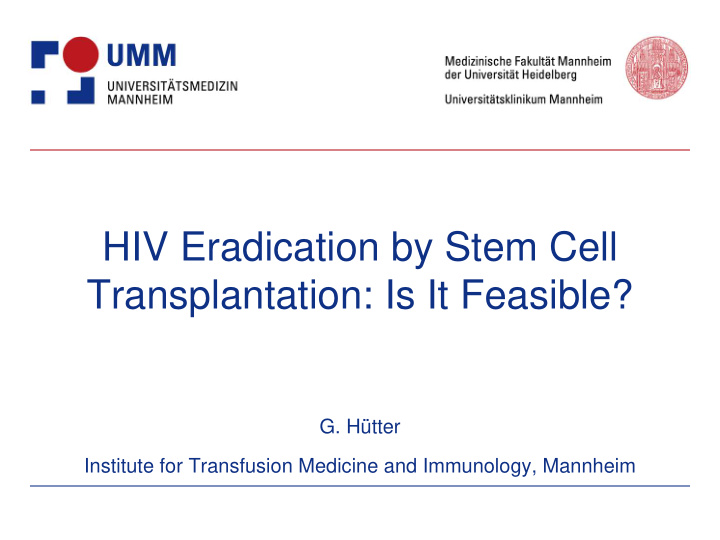



HIV Eradication by Stem Cell Transplantation: Is It Feasible? G. Hütter Institute for Transfusion Medicine and Immunology, Mannheim
The weapons of allo SCT Depletion of host immune system Reduction of the HIV reservoir? Replacement of host immune system Complete? Graft vs leukemia/tumour activity Is there a graft vs HIV activity?
Feasibility of allo SCT in patients with HIV 100 Percent survival With HAART (n=16) Without HAART (n=39) 50 0 0 25 50 75 100 Months elapsed But! No lasting effect on HIV infection!
Case report: patient ´ s history 40-year-old patient HIV infection since ´ 96 HAART since 2002 • HIV-1 RNA < detection limit • CD4 + T-cells 300-400 / l Donor request: 232 HLA identical! • No AIDS defining illnesses AML Spring 2006 weakness FAB M4 June ´ 06 anemia July ´ 06 pancytopenia 46XY
HIV transmission HIV-1 requires CD4 & CCR5 or CXCR4 CCR5- 32 deletion = > - Inactive receptor - Frequency 10-20% (1% homozygous) - CCR5- 32/ 32 resistant against R5 - in vivo highly resistant against X4 and dual
Frequency of the CCR5-delta32 allele
Donor search and genotyping 232 HLA identical donors therefrom 80 registered at the DKMS Request for blood samples CCR5- 32 screening Donor 61 CCR5- 32/ 32
Development of the CCR5- 32 genotype Control CCR5-+/+ CCR5-+/ 32 CCR5- 32/ 32 (donor) Patient before SCT Patient after SCT 168bp 200bp
HIV-1 & T-cell reconstitution after CCR5-delta 32 allo SCT HIV-1 RNA HAART HAART CD4+ T cell count 10 7 800 AML diagnosis 1 st allogeneic transplantation 100% chimerism 2 nd allogeneic transplantation AML relapse 10 6 600 10 5 500 HIV-1 RNA (cop/mL) 10 4 CD4+ T-cells (/ L) 400 10 3 300 10 2 200 100 + 1146 days -227 -206 + 61 + 391 + 416 -85 + 108 + 159 + 332 + 548 -4 HIV DNA env HIV DNA LTR
Determination of patient ´ s virus 97,1% R5 2,9 % X4 oder dual env 6537s and 7254as/ env 5as
x T r e t f a . o m 0 2 x T e r o f e B l o r t n o c p120 HIV-2 p41 p31 p24 p17 Serodeconversion
Immunohistology of intestinal mucosa (day + 159) CCR5+
CCR5 tissue chimerism (gut) 6 mo. after Tx 2 years after Tx T-lymphocytes macrophages
The “cure” question …sterilizing cure in this patient can only be clarified post mortem… Robert Gallo (Dec. 8, 2009 at the HIV Persistence Workshop, St. Martin)
Arguments to solve the “cure” question Good Fair Poor HIV RNA negative HIV DNA negative Single PCR negative Gut biopsies negative Brain biopsie negative No rebound Serodeconversion Normal CD4 cell count Tissue CCR5 chimerism
Arguments to solve the “cure” question Good Fair Poor HIV RNA negative X HIV DNA negative X Single PCR negative X X Gut biopsies negative Brain biopsie negative X No rebound X Serodeconversion X Normal CD4 cell count X X Tissue CCR5 chimerism
The “cure” question …sterilizing cure in this patient can only be clarified post mortem… Robert Gallo (Dec. 8, 2009 at the HIV Persistence Workshop, St. Martin) Does it make sense to search for sterilizing cure?
The search for patient No. 2 No. gender age diagnosis location HLA Donors CCR5 tested Status matching Donors (+ , + ) (+ , -) (-, -) 1 Male 40 AML Berlin, 232 52 12 1 Tx Feb ` 08 Germany 2 Male adult lymphoma Freiburg, yes ND died before Tx Germany 3 Female 3 DBA Heidelberg, 120 103 17 1* ongoing Germany + 1* 4 Male adult MDS Lausanne, 1 pending ongoing Switzerland 5 Male 29 lymphoma Mainz, 1 1 Tx Nov 2009 Germany 6 Male 15 leukaemia Jerusalem, 3 3* Jan 2010, died Israel + 3* after Tx 7 Male 50 CMML Berlin, 60 5 5 Tx in April 2010 Germany 8 Male adult lymphoma Mannheim, pending ongoing Germany *only 3/6 HLA-match
Summary Allo SCT in patients with HIV is feasible Allo SCT alone does not improve course of HIV infection Case of allo SCT with a CCR5-delta32 homozygous donor highlights the decisive role of CCR5 in maintaining HIV infection Allo SCT is not a “standard”-option for HIV treatment More cases necessary for further conclusions Can we translate this approach into a more feasible way?
Acknowledgements Med. Dept. III Charité CBF Inst. of Immunology Dr. D. Nowak Charité CM S. Ganepola S. Fuhrmann M. Mossner M. Streitz Dr. A. Müßig PD Dr. I.W. Blau Robert-Koch-Institut, Berlin Dr. O. Blau Dr. C. Kücherer Prof. L. Uharek Prof. W.K. Hofmann Prof. E. Thiel Inst. of clin. & molec. Virology, Erlangen Inst. of Virology Charité CM Dr. K. Metzner PD Dr. J. Hofmann Dr. M. Raftery Max-Plank-Institut Informatik, Saarbrücken DKMS A. Thielen Prof. G. Ehninger Dr. A. Schmidt P. Leuker Inst. of Biochemistry Charité CM Dr. M. Meixner In cooperation with: Med. Dept. I Charité CBF Jeffrey Laurence, Cornell Dr. K. Allers Frank Maldarelli, NCI Prof. T. Schneider Robert & Janet Siliciano, JHMI John Coffin, Tufts Stefan-Morsch-Foundation Nicole Bernard, McGill, Toronto E. Morsch John A. Zaia, City of Hope Supported by: amfAR
Recommend
More recommend